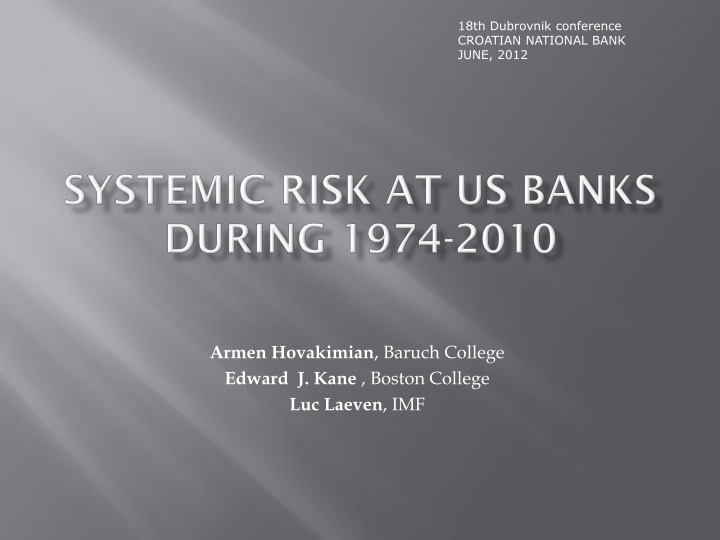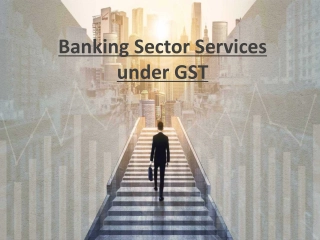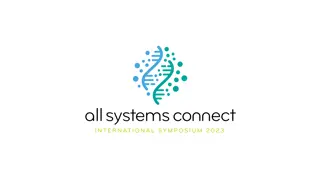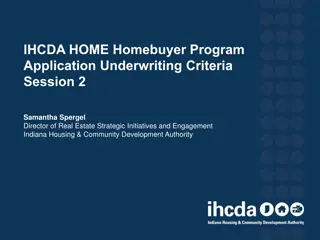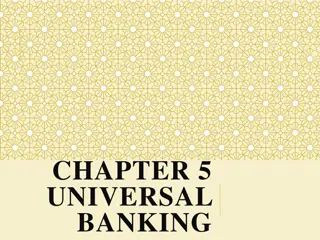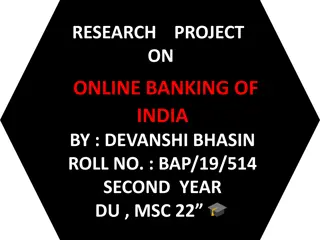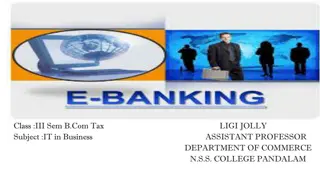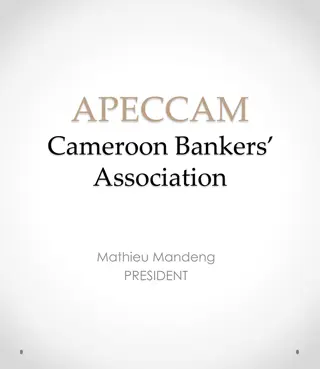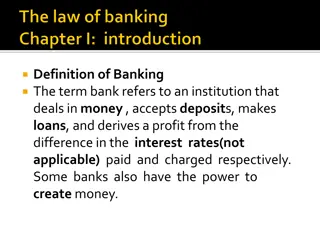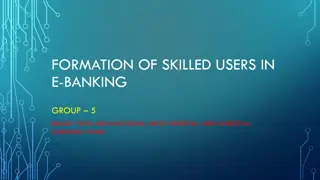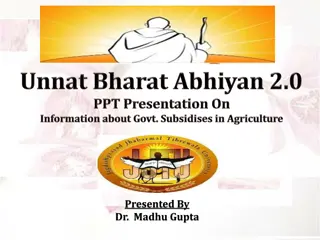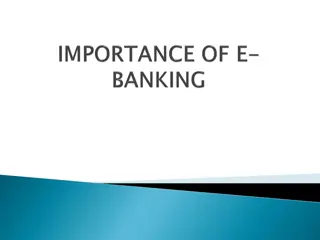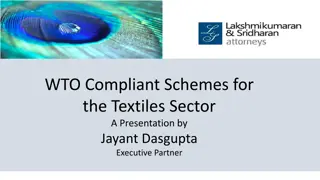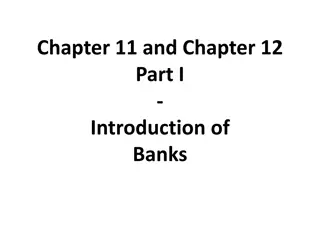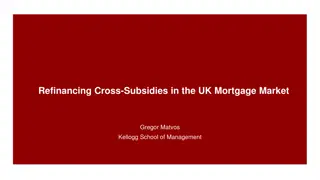Macroprudential Risk and Safety Net Subsidies in Banking Systems
This content delves into the complex interplay of macroprudential risk arising from industry risk-taking and authorities' selective exercise of rescue options in banking systems. It explores how large banking organizations exploit safety nets and regulatory loopholes, shifting considerable risk to taxpayers and small banks. Accountability, implicit guarantees, and the valuation of taxpayer support in financial distress are key themes discussed.
Download Presentation

Please find below an Image/Link to download the presentation.
The content on the website is provided AS IS for your information and personal use only. It may not be sold, licensed, or shared on other websites without obtaining consent from the author.If you encounter any issues during the download, it is possible that the publisher has removed the file from their server.
You are allowed to download the files provided on this website for personal or commercial use, subject to the condition that they are used lawfully. All files are the property of their respective owners.
The content on the website is provided AS IS for your information and personal use only. It may not be sold, licensed, or shared on other websites without obtaining consent from the author.
E N D
Presentation Transcript
18th Dubrovnik conference CROATIAN NATIONAL BANK JUNE, 2012 Armen Hovakimian, Baruch College Edward J. Kane , Boston College Luc Laeven, IMF
We contend: (1) that macroprudential risk comes from a combination of (a)industry risk-taking that creates PD and LGD and (b)authorities selective exercise of a Rescue Option and (2)that the rescue option shifts considerable risk to taxpayers and small banks. Large banking organizations turn this option into a conditioned Reflex by finding ways to make themselves harder and scarier for authorities to fail and unwind. They do this by increasing their size, complexity, leverage, and/or maturity mismatch. The FDIC is accountable for Microprudential Risk. But Safety nets subsidize systemic risk creation in good times partly because the accounting frameworks used by banks and government officials do not make anyone directly accountable for reporting or controlling safety-net subsidies until and unless markets sour. 2
When it comes to haircutting creditors and counterparties in horrific firms like AIG, I wish our Regulators had the Courage of the Banks they are supposed to supervise. 4
The per-period flow of safety-net benefits that a particular bank enjoys can be defined as a fair annual insurance premium percentage (IPP) expressed per dollar of the institution s debt. We interpret a firm s systemic risk as the value of its option to put potentially ruinous losses and loss exposures to taxpayers. Its managers ability to trigger forbearance for capital shortages and stand-alone tail-risk (i.e., losses that exceed taxpayers value-at-risk supervisory protection) increases the value of the safety-net benefits it receives. This creates an incentive for managers to search out, to lobby for, and to exploit weaknesses (i.e., loopholes) in risk-control arrangements.
To establish accountability, banks and governments need to be made to account for the way in which, when important firms fall deeper and deeper into distress, implicit and explicit taxpayer guarantees absorb much of the markdowns that would otherwise have to occur. In accounting parlance, a contra-liability is an item that is entered on a firm's balance sheet when and to the extent that responsibility for servicing some of its debt falls on a third party. For banks, financial safety nets transform a block of unknown taxpayers into just such a third party. The unacknowledged value of taxpayer guarantees are, economically, an unbooked contra- liability of the modern commercial and investment bank and an unbooked, and uncertainly dated, liability of the taxpaying households and firms. 8
Assets 100 80 Debt 95 (Guarantee ) 1 6 Market Cap 6 1 9
Assets 500 450 Debt 400 390 (due to limited debt relief) TBTF Guarantees 2 3 97 28 Economic Net Worth 10
Our modeling procedure follows Merton (1977) in portraying taxpayer credit support as a one-year European put option on the bank s assets.. Merton portrays safety-net access as an option that allows bank owners to put the bank to safety-net managers for the face value of the bank s debt. We allow authorities to refuse to exercise taxpayer s side of the put (Kane, 1986). [As observable input variables, our models use the book value of debt (B), the market value of a bank s or bank holding company s equity (E), the standard deviation of the return on equity ( E) and the fraction of bank assets distributed yearly as dividends to stockholders ( ). The synthetic variable IPP expresses the fair annual premium for stand-alone safety-net support per dollar of debt.] Merton (1977, 1978) shows that the IPP increases both with a bank s leverage and with the volatility of its return on assets. In Merton s model, leverage is measured as the ratio of the par value (B) of deposits and other debt to the market value of a bank s assets (V). Volatility is defined as the standard deviation of the return on bank assets ( V). 12
Unique features of our analysis: We distinguish a bank s stand-alone risk from its systemic risk and we recognize that mischaracterizing insolvency issues as liquidity problems allows a flow of zombie-institution dividends to continue.
We conceive of IPP as the dividend that taxpayers would be paid on their contingent equity stake in a given firm if information asymmetries did not exist. The value of a bank s taxpayer put increases with the extent to which creditors and stockholders are confident that they can scare or pressure authorities into shifting ruinous losses to taxpayers without adequate compensation. We develop two different opportunity-cost measures of the costs of taxpayer support: The stand-alone IPP with prompt resolution: the IPD The systemic-risk IPP that incorporates an implicit estimate of likely forbearance: the IPDS.
Over 1974-2010, we measure a banks contribution to systemic risk relative to the IPP that our model implies quarter by quarter for the portfolio of sample banks taken together. A bank s systemic risk (IPDS) is the difference between the IPD that arises for the sectoral portfolio when that particular bank is and is not included. 15
Panel A. Top 10 banks Ranked by Stand-Alone Risk # 1 2 3 4 5 6 7 8 9 10 Bank 1st Pacific Bancorp Bay National Corp Pacific State Bancorp/CA First Bankshares Inc/VA Community Shores Bank Corp Crescent Banking Co Ohio Legacy Corp Sun American Bancorp Bank of the Carolinas Sterling Banks Inc Regulatory or market response Shut down Shut down Shut down Acquired Consent order Shut down Consent order Shut down Consent order Shut down Panel B. Top 10 banks Ranked by Systemic Risk Bank State Street Corp Wells Fargo & Co PNC Financial Services Group 2009 Q1 Trico Bancshares Regions Financial Corp Banctrust Financial Group Marshall & Ilsley Corp Bank of America Corp Pacwest Bancorp Frontier Financial Corp Fiscal Quarter 2009 Q1 2009 Q1 Assets ($ million) 142,144 1,285,891 286,422 1,976 144,292 2,088 61,790 2,321,963 4,496 4,245 # 1 2 3 4 5 6 7 8 9 10 2008 Q3 2008 Q3 2008 Q4 2009 Q1 2009 Q1 2008 Q4 2008 Q3 16
Mean Stand-Alone Risk (IPD) at Sampled Banks 800 700 600 500 400 300 200 100 0 74 76 78 80 82 84 86 88 90 92 94 96 98 00 02 04 06 08 10 17
Using the Dividend-Forbearance Model 700 600 500 400 300 200 100 0 7 4 7 5 7 6 7 7 7 8 7 9 8 0 8 1 8 2 8 3 8 4 8 5 8 6 8 7 8 8 8 9 9 0 9 1 9 2 9 3 9 4 9 5 9 6 9 7 9 8 9 9 0 0 0 1 0 2 0 3 0 4 0 5 0 6 0 7 0 8 0 9 1 0 Introducing a Dividend Stopper 400 350 300 250 200 150 100 50 0 7 4 7 5 7 6 7 7 7 8 7 9 8 0 8 1 8 2 8 3 8 4 8 5 8 6 8 7 8 8 8 9 9 0 9 1 9 2 9 3 9 4 9 5 9 6 9 7 9 8 9 9 0 0 0 1 0 2 0 3 0 4 0 5 0 6 0 7 0 8 0 9 1 0 18
Bank risk-taking increases in late booms and gets worked down again as economic recovery takes hold. Subsidies surged in every downturn. Disguised Bank risk-taking increased markedly after the S&L mess. Megabankers recognized how reluctant authorities were to address a pattern of industry insolvency. The Fed s Pre-AIG/Lehman reluctance to conduct triage and impose immediate dividend stoppers in their 2007-2008 rescue programs cost taxpayers a lot on average. 1. 2. 3. 19
Although Accounting and Tier-1 Capital Ratios were controlled, the Model-Implied ratio of market value capital went down sharply from 2006 on. The Lehman-AIG double U-Turn merely surfaced longstanding weakness. Our straightforward and easy-to-calculate measures could have been used in potentially golden moments to uncover and mitigate the last round of efforts to arbitrage capital requirements. 20
Golden Moments: Loans Got Worse and Worse As We Neared the Breaking Point 21
Implied Ratio of Capital to Assets at Sampled Institutions 25% 20% 15% 10% 5% 0% 74 76 78 80 82 84 86 88 90 92 94 96 98 00 02 04 06 08 10 22
0.600 0.500 0.400 0.300 0.200 0.100 0.000 18 35 52 69 86 1 103 120 137 154 171 188 205 222 239 256 273 290 307 324 341 358 375 392 409 426 443 460 477 23
Mean Systemic Risk Premium at Sampled Institutions 500 0 74 76 78 80 82 84 86 88 90 92 94 96 98 00 02 04 06 08 10 -500 -1000 -1500 -2000 -2500 24
Mean Systemic Risk Premium for Large Banks Only 450 400 350 300 250 200 150 100 50 0 74 76 78 80 82 84 86 88 90 92 94 96 98 00 02 04 06 08 10 -50 25
Along with ordinary taxpayers, small banks have been supporting rather than exploiting the safety net. Anticipated increases in explicit and implicit premiums from post-crisis re-regulation are expected to fall proportionately more heavily on small banks. 26
Other Measures Our Measures Stand-alone Risk Premium IPD (bp) 619 617 232 916 800 521 80 3240 319 433 56 126 343 297 326 896 25 144 Value of Stand-alone Support ($MM) 127300 Value of Systemic Risk Support ($MM) Systemic Risk Premium IDPS (bp) Acharya et al. MES ($Bil) SCAP/Tier1 Capital 19.57% 15.86% SCAP ($Bil) 33.9 13.7 5.5 2.5 2.2 1.8 1.8 1.1 0.6 15.05 10.57 14.98 14.80 12.91 15.44 15.17 14.39 10.55 9.75 11.09 10.45 8.54 14.79 9.57 10.52 9.97 10.28 40882 40186 37577 2265 3986 1912 8418 3173 5881 2755 -8965 16893 6021 2109 3197 2156 10407 6376 199 337 212 177 251 214 133 300 228 266 -510 90 249 149 232 147 125 132 Bank of America Corp Wells Fargo & Co Citigroup Inc Regions Financial Corp Suntrust Banks Inc Keycorp Morgan Stanley Dean Witter & Co Fifth Third Bancorp PNC Financial Services GRP INC American Express Co Bank New York Inc JPMorgan Chase & Co US Bancorp State Street Corp BB&T Corp Capital One Financial Corp Goldman Sachs Group Inc Metlife Inc 73645 41073 11692 12690 4662 5100 34300 8249 4489 985 23715 8302 4204 4491 13137 2047 6960 4.63% 20.66% 12.50% 15.52% 3.81% 9.24% 2.49% 0.00% 0.00% 0.00% 0.00% 0.00% 0.00% 0.00% 0.00% 0.00% 0 0 0 0 0 0 0 0 0 Notes: SCAP is the capital shortfall calculated in the supervisory Capital Assessment Program conducted in February 2009 and MES is the Marginal Expected Shortfall calculated by Acharya et al. (2010) from data in periods during which stock-market returns lie below their fifth percentile. 27
Ever wonder how taxpayers and small banks will pay for megabank rescues? 29
